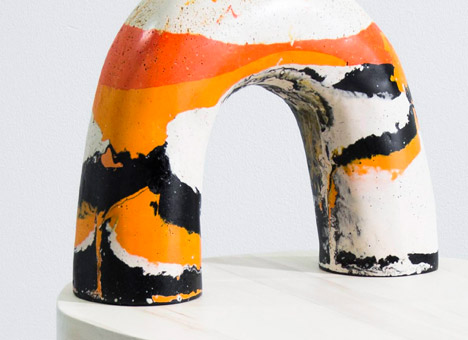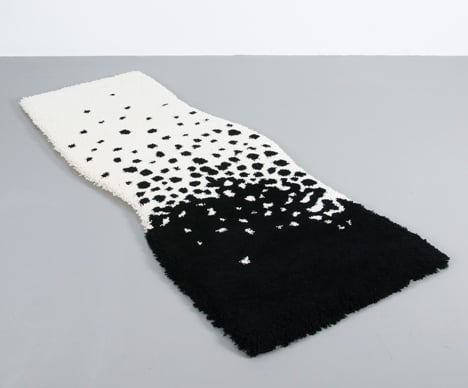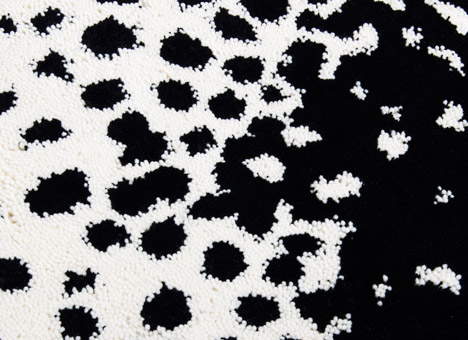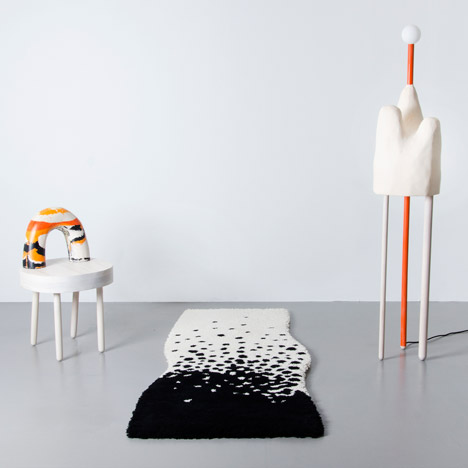Erika Emerén designs furniture by scaling up plasticine models
Graduate shows 2015: designer Erika Emerén created the shapes and patterns of the chair, lamp and rug in her graduate collection by playing with plasticine (+ slideshow).
Emerén developed her collection, titled Transforming the White Cube, while studying at Beckmans College of Design in Stockholm.
Her use of the children's modelling material in the project was an attempt to "break free" from the "meta-modernistic" curriculum she completed over the three-year course.

"This project is a way of asking why so much is still like a white cube: geometric and sleek," she said. "By challenging the norm we can broaden our way to look at products and in the long run find a more personal and sustainable way to use and consume."
Her range includes a chair, a rug and a lamp – featuring unconventional forms and blotchy patterns often created when mixing coloured plasticine.
The chair comprises a chunky seat and rounded legs – both in wood – and an arch-shaped backrest cast in jesmonite – a composite of a gypsum-based material and acrylic resin.

Often used in sculpture, jesmonite has also been used by designers Els Woldhek and Georgi Manassiev to cast containers made of cork granules, while London designer Klemens Schillinger used liquid jesomite to colour his concrete tabletop accessories based on the shapes of ancient Greek and Mayan architecture.
The thick tube mounted onto the seat is patterned with swirls of orange, black and white.
"Orange was chosen because of its vibrancy – it makes a nice contrast towards black and white," the designer told Dezeen.

The rug subverts the traditional rectangular shape with wavy edges, and is made of industrially tufted wool. Its pattern gradually transitions from black into white from one end to the other.
"Its wave-like shape contrasts to the usual rectangular carpets we see in interiors today," said Emerén. "Yet this carpet is no more difficult to produce than a rectangular one."

The lamp is partly cast and partly sculptured in jesmonite and wood, and is described by the designer as "a combination of minimalistic legs piercing through an organic body".
She argues that, while most lamps are minimalistic in their design, this one blurs the boundaries between design and sculpture, and highlights the discussion "of what is and what is not" considered design.
Related content: see more projects from 2015 design graduates
Emerén came up with the forms through making models with plasticine and then replicating them at full size. She chose to incorporate traditional materials and forms, such as the wooden legs, to contrast with the playful, organic forms.

"A lamp, carpet and a chair: all of them sprung from an idea of liberation from a white cube," she told Dezeen. "The process contained a lot of play and I wanted the result to feel as playful as the clay experiments. Playfulness in form is not a white cube; it is organic and asymmetric in its shape."
The rug is the only one of the three that would be possible to produce industrially in its current form, but the designer is keen to work on that.
"I would like to keep on developing the chair and the lamp to make them more accessible," she said. "It would be very interesting to bring this method to the industry."
Another Beckmans student that experimented with unusual materials this year used dust from the floors of vintage clothes shops to form a collection of furniture.